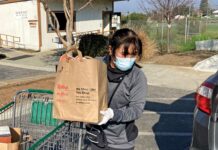Atrip to the produce section of any grocery store will reveal customers whacking watermelons, squeezing peaches and smelling cantaloupe, trying to find good summer fruit. Is there a reliable way to test fruit for ripeness without eating it first, or is all that slapping and sniffing just for show?
Diana Torres, of Gilroy, relies on similar methods to chose her fruit.
“A lot of them might be old wives tales, but that’s how my mom taught me,” she said.
Other customers pass on manhandling the fruit, preferring to make a selection based on overall appearance. “I make sure it looks healthy,” said Mike Botille of Gilroy. “I don’t beat on ’em or throw them around.”
Color, firmness, scent and texture are all indications of good fruit, according to Filemon Bobadilla, produce manager at Nob Hill Foods in Gilroy. Knowing what a good piece of fruit looks, feels and smells like will make it easier to bring home produce that’s ripe and tasty.
Peaches come to the store in two types: picked prior to ripening and tree-ripened. Peaches picked before they’re ripe should have a round shape, mostly red coloring with some yellow and should be a little soft. Avoid peaches that are too soft or have soft spots – this is a sign they’re overripe. Tree-ripened peaches are ready to eat, but should also be firm. The same goes for nectarines, plums, apricots and cherries.
Choosing grapes is mostly a matter of size and color. Firmer, lighter-colored grapes are best, said Bobadilla. Bunches with small, dark grapes will be sour, not sweet. To check the overall quality of a bunch, pick it and give it a gentle shake – none of the grapes should fall off.
Now is the perfect time to find good watermelon at the store, said Bobadilla. “Seventy percent of the time, when they’re in season, they’re supposed to be good,” he said. Watermelons in season have grown under ideal conditions: the soil, weather and water are just right to produce a good watermelon. To pick one from the produce section, hold it up and give it a few light whacks. If the sound is clear and resonant, “like a basketball,” the watermelon is ready to eat.
Honeydew melon should have a golden skin and a sweet aroma. Press around the stem area on melons such as crenshaw or golden honeydew: The softer the area, the softer the flesh of the melon will be. Choosing cantaloupe depends on when it’ll be eaten. For a ready-to-eat melon, choose one that is light in color and slightly soft. One that is greener and firmer will keep one or two days at home.
The best way to choose berries is by color, said Bobadilla. Strawberries should be completely red, and the best ones will still have a green stem attached. Raspberries should be free of dark spots and moisture.
Apples aren’t in season yet, so it’s harder to make a good selection. “If you can, stay away from apples this month,” Bobadilla advised. Many apples come from Washington, where the harvest is August and September – Washington apples in stores now have been in storage since last summer. To satisfy an apple craving right now, try to find ones grown in New Zealand, where it’s harvest time. Varieties from New Zealand include Gala, Fuji and Braeburn apples.
To select a good avocado, hold it in your palm and use the whole hand to test firmness, instead of poking at spots with fingers. A ready-to-eat avocado should be slightly soft; one that will be eaten in a few days should be firmer.
There are several kinds of bananas to chose from. A ready-to-eat yellow banana should be completely yellow – no green or brown spots. To keep bananas a few days before eating, buy them slightly green. When a recipe calls for overripe bananas, look for lots of brown spots. Red bananas should be slightly soft. Plantains that will be cooked should be green and firm; to eat them, chose one that is completely black and soft.
To ripen fruit quickly at home, Bobadilla suggested surrounding it with bananas and tomatoes. Both emit ethylene gas, which plants use to regulate growth. Storing fruit around high concentrations of the gas will hasten the ripening process. “They will be ripe probably by the end of the day,” he said.
In general, there are a few basic rules for choosing any kind of fruit. Try to find a good example of what a particular piece of fruit should look and feel like. Soft fruit shouldn’t be rock hard or too squishy, and a firm fruit shouldn’t give much when squeezed. Bobadilla emphasized color as a very important aspect of fruit selection. “Most of the time,” he said, “nice color is a good indication of a nice fruit.”











